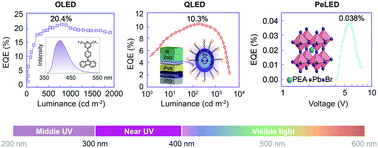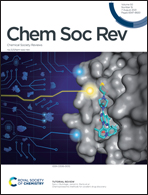Electroluminescent materials toward near ultraviolet region†
Abstract
Near ultraviolet (NUV) light-emitting materials and devices are significant due to unique applications in anti-counterfeit, manufacturing industries, and hygienic treatments. However, the development of high-efficiency NUV electroluminescent devices encounters great challenges and is far behind their RGB emitter counterparts. Besides the photoluminescence quantum yields (PLQYs) of NUV materials being higher than 40%, charge injection and lopsided carrier transport also determine the device performance, leading to great efforts in optimizing the frontier molecular orbitals to fit the adjacent function layer. In the exploration of NUV materials, organic molecules are one of the primary candidates, given their preparative facility and structural variability. Recently, all-inorganic quantum-dot light-emitting diodes (QLEDs) of Cd-based, ZnSe, graphene and inorganic perovskite emitters and organic–inorganic hybrid lead halide perovskite nanocrystals (NCs) were demonstrated for achieving NUV electroluminescence. Owing to the great efforts devoted to NUV material engineering and device configuration, NUV materials and devices have achieved great advances over the last two decades. In this review, we retrospect the development of NUV materials and devices covering all promising systems, which may inspire the enthusiasm of researchers to explore the huge potential in the NUV region.



 Please wait while we load your content...
Please wait while we load your content...